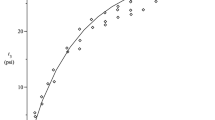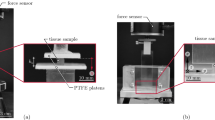Abstract
What-You-Prescribe-Is-What-You-Get (WYPIWYG) procedures are a novel and general phenomenological approach to modelling the behavior of soft materials, applicable to biological tissues in particular. For the hyperelastic case, these procedures solve numerically the nonlinear elastic material determination problem. In this paper we show that they can be applied to determine the stored energy density of superficial fascia. In contrast to the usual approach, in such determination no user-prescribed material parameters and no optimization algorithms are employed. The strain energy densities are computed solving the equilibrium equations of the set of experiments. For the case of superficial fascia it is shown that the mechanical behavior derived from such strain energies is capable of reproducing simultaneously the measured load-displacement curves of three experiments to a high accuracy.







Similar content being viewed by others
References
Abbasi, M., M. S. Barakat, K. Vahidkhah, and A. N. Azadani. Characterization of three–dimensional anisotropic heart valve tissue mechanical properties using inverse finite element analysis. J. Mech. Behav. Biomed. Mater., in press. doi: 10.1016/j.jmbbm.2016.04.031.
Chandran, P.L., and V. H. Barocas. Affine versus non-affine fibril kinematics in collagen networks: theoretical studies of network behavior. J. Biomech. Eng. 128:259–270, 2006
Chen, H., Y. Liu, X. Zhao, Y. Lanir, and G. S. Kassab. A micromechanics finite-strain constitutive model of fibrous tissue. J. Mech. Phys. Solid 59(9):1823–1837, 2011
Cortes, D. H., S. P. Lake, J. A. Kadlowec, L. J. Soslowsky, and D. M. Elliott (2010). Characterizing the mechanical contribution of fiber angular distribution in connective tissue: comparison of two modeling approaches. Biomech. Model. Mechanobiol. 9(5), 651–658, 2010.
Dokos, S., B. H. Smaill, A. A. Young, and I. J. LeGrice. Shear properties of passive ventricular myocardium. Am. J. Physiol. Heart. Circ. Physiol. 283(6), H2650–H2659, 2002
Eng, C. M., F. Q. Pancheri, D. E. Lieberman, A. S. Biewener, and L. Dorfman. Directional differences in the biaxial material properties of fascia lata and the implications for fascia function. Ann. Biomed. Eng. 42:1224–1237, 2014.
Evans, S.L., and C. A. Holt. Measuring the mechanical properties of human skin in vivo using digital image correlation and finite element modelling. J. Strain Anal. 44:337–345, 2009.
Freed, A. D., D. R. Einstein, and I. Vesely. Invariant formulation for dispersed transverse isotropy in aortic heart valves: an efficient means for modeling fiber splay. Biomech. Model. Mechanobiol. 4(2–3):100–117, 2005
Gasser, T., R. Ogden, and G. A. Holzapfel. Hyperelastic modelling of arterial layers with distributed collagen fiber orientations. J. R. Soc. Interface, 3:13–35, 2006.
Groves, R.B., S. A. Coulman, J. C. Birchall, and S. L. Evans. An anisotropic, hyperelastic model for skin: experimental measurements, finite element modelling and identification of parameters for human and mourine skin. J. Mech. Behav. Biomed. Mater. 18:167–180, 2013.
Holzapfel, G.A., T. Gasser, and R. W. Ogden. A new constitutive framework for arterial wall mechanics and a comparative study of material models. J. Elast. 61:1–18, 2000.
Holzapfel, G.A., and R. W. Ogden. Constitutive modelling of passive myocardium: a structurally based framework for material characterization. Philos. Trans. R. Soc. Lond. A 367(1902), 3445–3475, 2009.
Holzapfel, G. A., and R. W. Ogden. On the tension-compression switch in soft fibrous solids. Eur. J. Mech. A, 49:561–569, 2015.
Horgan, C.O., and J. G. Murphy. Simple shearing of soft biological tissues. Proc. R. Soc. Lond. A 467: 760–777, 2011.
Humphrey, J.D. Cardiovascular Solid Mechanics: Cells, Tissues, and Organs. New York: Springer, 2013.
Lake, S.P., M. F. Hadi, V. K. Lai, and V. H. Barocas. Mechanics of a fiber network within a non-fibrilar matrix: model and comparison with collagen-agarose cogels. Ann. Biomed. Eng. 40(10):2111–2121, 2012.
Lanir, Y. A structural theory for the homogeneous biaxial stress-strain relationships in flat collagenous tissues. J. Biomech. 12(6):423–436, 1979.
Lanir, Y. Constitutive equations for fibrous connective tissues. J. Biomech. 16(1):1–12, 1983.
Latorre, M., F. and J. Montáns. Extension of the Sussman–Bathe spline-based hyperelastic model to incompressible transversely isotropic materials. Comput. Struct. 122:13–26, 2013.
Latorre, M., F. J. Montáns. What-You-Prescribe-Is-What-You-Get orthotropic hyperelasticity. Comput. Mech. 53(6): 1279–1298, 2014.
Latorre, M., F. J. Montáns. Material-symmetries congruency in transversely isotropic and orthotropic hyperelastic materials. Eur. J. Mech. A 53:99–106. 2015.
Latorre, M., and F. J. Montáns. On the tension-compression switch of the Gasser-Ogden-Holzapfel model: Analysis and a new pre-integrated proposal. J. Mech. Behav. Biomed. Mater. 57, 175–189, 2016.
Li, K., R. W. Ogden, and G. A. Holzapfel. Computational method for excluding fibers under compression in modeling soft fibrous solids. Eur. J. Mech. A 57, 178–193, 2016.
Murphy, J.G. Evolution of anisotropy in soft tissue. Proc. R. Soc. Lond. A 470 (2161), 20130548, 2014.
Pancheri, F.Q., C. M. Eng, D. E. Lieberman, A. S. Biewene, and L. Dorfman. A constitutive description of the anisotropic response of the fascia lata. J. Mech. Behav. Biomed. Mater. 30:306–323, 2014.
Ruiz-Alejos, D., J. A. Peña, M. M. Perez, and E. Peña. Experiments and constitutive model for deep and superficial fascia. Digital image correlation and finite element validation. Strain, 2016. in press. doi:10.1111/str.12198.
Skacel, P., and J. Bursa. Poisson’s ratio of arterial wall–Inconsistency of constitutive models with experimental data. J. Mech. Behav. Biomed. Mater. 54, 316–327, 2016.
Sommer, G., M. Eder, L. Kovacs, H. Pathak, L. Bonitz, C. Mueller, P. Regitnig, and G. A. Holzapfel. Multiaxial mechanical properties and constitutive modeling of human adipose tissue: a basis for preoperative simulations in plastic and reconstructive surgery. Acta Biomater. 9: 9036–9048, 2013.
Sommer, G., A.J. Schriefl, M. Andra, M. Sacherer, C. Viertler, H. Wolinski, and G.A. Holzapfel. Biomechanical properties and microstructure of human ventricular myocardium. Acta Biomater. 24: 172–192, 2015.
Stylianopoulos, T., and V. H. Barocas. Multiscale, structure-based modeling for the elastic mechanical behavior of arterial walls. J. Biomech. Eng. 129(4): 611–618, 2007.
Sussman, T., and K. J. Bathe. A model of incompressible isotropic hyperelastic material behavior using spline interpolations of tension-compression test data. Commun. Numer. Methods Eng. 25(1):53–63, 2009.
Tian, L., J. Henningsen J, M. R. Salick, W. C. Crone, M. Gunderson, S. H. Dailey, and N. C. Chesler. Stretch calculated from grip distance accurately approximates mid-specimen stretch in large elastic arteries in uniaxial tensile tests. J. Mech. Behav. Biomed. Mater. 47, 107–113, 2015.
Wang, H.Q., Y.Y. Wei YY, T. Sacks, Z. Wu, and Z.J. Luo. Impact of leg lengthening on viscoelastic properties of the deep fascia. BMC Musculoskelet. Disord. 10:105–110, 2009.
Weiss, J. A., J. C. Gardines, and C. Bonifasi-Lista. Ligament material behavior is nonlinear, viscoelastic and rate-independent under shear loading. J. Biomech. 35:943–950, 2002.
Zang, L., S. P. Lake, V. K. Lai, C. R. Picu, V. H. Barocas, and M. S. Shephard. A coupled fiber-matrix model demonstrates highly inhomogeneous microstructural interactions in soft tussues under tensile load. J. Biomech. Eng. 135(1):011008, 2013.
Acknowledgments
Partial financial support for this work has been given by Grants DPI2015-69801-R and DPI2013-44391-P from the Dirección General de Proyectos de Investigación of the Ministerio de Economía y Competitividad of Spain. F.J. Montáns also acknowledges the support of the Department of Mechanical and Aerospace Engineering of University of Florida during the sabbatical period in which this paper was finished, and Ministerio de Educación Cultura y Deporte of Spain for the financial support for that stay under Grant PRX15/00065. The ADINA program license used for this work has been a courtesy of ADINA R&D to the Universidad Politécnica de Madrid.
Author information
Authors and Affiliations
Corresponding author
Additional information
Communicated by Eiji Tanaka.
Rights and permissions
About this article
Cite this article
Latorre, M., Peña, E. & Montáns, F.J. Determination and Finite Element Validation of the WYPIWYG Strain Energy of Superficial Fascia from Experimental Data. Ann Biomed Eng 45, 799–810 (2017). https://doi.org/10.1007/s10439-016-1723-2
Received:
Accepted:
Published:
Issue Date:
DOI: https://doi.org/10.1007/s10439-016-1723-2




